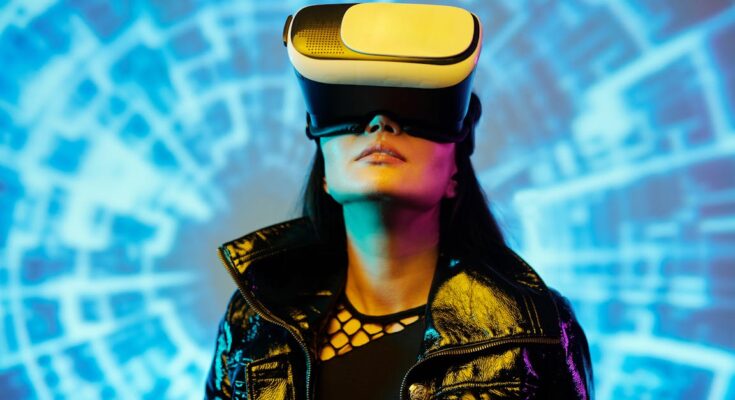Alright, so you’ve probably heard people talking about AR and VR, maybe seen folks with big goggles on or pointing their phones at stuff to see things pop up. It’s all pretty cool, but also a little confusing, right? Like, what’s the real difference, and where is all this headed? Especially as we look towards 2025, it feels like one of these is going to really take off and maybe change how we do things. You’re wondering which one is going to be the big deal – which tech wins the popularity contest or becomes super useful first? This article is gonna break it all down for you. We’ll explore what AR and VR are actually good for, see where they stand now, and take a peek at what they might look like in just a couple of years. By the end, you’ll have a much clearer picture of which one might be the ‘winner’ in 2025, depending on what you mean by winning.
Wait, What Are We Even Talking About: AR and VR?
Okay, let’s start with the basics, just so we’re all on the same page. VR stands for Virtual Reality. Think of it like stepping into a completely different world. You put on a headset, and suddenly, your old living room is gone, replaced by, say, a spaceship or a medieval castle. It’s all about immersion – making you feel like you’re really there. You can look around, interact with things in that digital space, and totally escape your surroundings.
AR is Augmented Reality. This is different because it doesn’t replace your world; it adds to it. You’re still seeing your living room, but maybe there’s a digital dinosaur walking across the floor, or information popping up about the painting on your wall. It augments, or adds to, your real-life view. You often use your phone screen for this right now, but the goal is definitely glasses or lenses.
VR: Escaping into Another Place
When you strap on a VR headset, you’re making a conscious choice to leave your physical space behind for a bit. Right now, VR is huge for gaming. You can swing a virtual lightsaber, explore fantasy lands, or even get a workout in a digital boxing ring. It’s incredibly powerful for simulations too. Like, imagine future mechanics learning to fix an engine by taking it apart in VR, or doctors practicing surgery without needing a real body. It lets you do stuff that might be too dangerous, expensive, or just impossible in the real world.
Think about our friend, Sarah. She’s a gamer who loves exploring new worlds. With her VR headset, she can climb virtual mountains or defend a castle with her friends online, feeling like she’s truly *there* even though she’s just in her bedroom. It’s a total escape, a deep dive into a digital adventure.
AR: Bringing the Digital World to Your World
AR is more about convenience and adding helpful stuff to your everyday life. You’ve probably used AR without even realizing it! Remember those silly social media filters that put dog ears on you or change your hair color? That’s basic AR. How about using your phone camera to see how a new couch would look in your living room before you buy it? Or using a map app that shows arrows overlaid on the street view to tell you which way to walk? That’s all AR in action.
Imagine our other friend, Mike. He’s trying to assemble some furniture. Instead of fumbling with confusing paper instructions, he points his phone at the box, and an AR app pops up, showing him exactly where each piece goes, overlaid on his actual table. It’s about making real tasks easier and more informative by blending digital info into his view of the world.
Where Are They Right Now? Who’s Using Them?
Today, VR is still a bit niche. Most people who own headsets are gamers or tech enthusiasts. Businesses are definitely using it for things like employee training (imagine practicing safety procedures in a virtual factory!) or designing things in 3D. But you don’t see everyone walking around with a VR headset, right? It’s a dedicated experience, usually done at home or in a specific place.
AR, on the other hand, is already in everyone’s pocket if they have a smartphone. Millions of people use AR apps every day, whether it’s for fun filters, shopping tools, or navigation. Purpose-built AR glasses aren’t really a consumer thing yet – they’re mostly for industrial uses or still in development, like those being worked on by big tech companies. So, AR has a much wider user base *right now*, even if it’s often through a phone screen.
Fast Forward to 2025: What’s Changing for VR?
By 2025, VR headsets are expected to be way better. Lighter, more comfortable, higher resolution screens so things look sharper, maybe even wireless for real freedom. There will be more games, more social experiences, and probably more ways to use VR for work or learning. We might see more ‘VR cafes’ or public spaces too.
However, VR still faces some challenges. It can be a bit isolating since you’re cut off from your physical surroundings. And while the tech is getting cheaper, really high-end VR can still be a chunk of change. It’ll likely remain the go-to for truly immersive experiences and specific professional uses, but maybe not something everyone uses daily for just anything.
Fast Forward to 2025: What’s Changing for AR?
2025 could be a really interesting year for AR. While AR glasses might still be finding their footing in the mainstream consumer market, phone-based AR will be way more advanced. Expect apps that can do cooler things, understand your environment better, and be more seamlessly integrated into everyday tasks like shopping, learning, and getting around. And maybe, just maybe, we’ll start seeing those sleek AR glasses become a bit more common, moving beyond just early adopters.
The real potential for AR by 2025 is its ability to blend into our lives without taking us out of the real world. Imagine getting directions that float over the street ahead of you, or seeing reviews pop up over restaurants as you walk by. It has the potential to be less of a dedicated ‘experience’ and more of a constant, helpful layer on top of reality.
Thinking About Real Life: Which One Fits Better?
Think about your average day. How often do you want to totally replace your reality? Probably not all that often, right? You need to see where you’re going, talk to people around you, and interact with physical objects. This is where AR shines. It can help you *while* you’re doing real-world stuff. Need help fixing something? AR overlay. Can’t remember someone’s name at a party? Maybe subtle AR info pops up. Looking for a specific item in a busy store? AR navigation could guide you.
VR, on the other hand, is perfect for when you *do* want to escape. Want to visit a museum on the other side of the world? Jump into VR. Want to play a game that makes you feel like you’re flying? VR is your friend. They serve different purposes. One enhances reality, the other creates a new one. For most people’s daily grind, enhancing reality seems like the more frequent need.
The Big Question: Which One Feels Like It’s ‘Winning’ by 2025?
So, who’s the champ in 2025? It’s not really about one killing the other off. They’re different beasts. But if ‘winning’ means reaching more people, becoming part of more everyday tasks, and having a broader impact on how we interact with information and the world around us, then AR seems to have the edge by 2025. It’s already on your phone, which is a massive head start. As AR tech gets better, especially if those AR glasses start to become a real thing, its potential for widespread adoption in daily life feels stronger for the near future.
VR will keep getting better and be amazing for gaming, training, and super immersive experiences. It will definitely ‘win’ in specific scenarios where total immersion is the goal. But for integrating tech into the fabric of our normal day-to-day lives, AR looks poised to be the one making bigger strides and reaching a wider audience by 2025. It’s less about escaping your world and more about making your world smarter and more interesting.
Okay, so wrapping it all up, we looked at AR and VR, these two cool technologies changing how we see and interact with stuff. VR is your ticket to completely new, digital worlds – awesome for games, simulations, and deep dives into virtual spaces. AR is about adding digital layers onto the real world you’re already in, super handy for things like navigation, information overlays, and even shopping. Right now, AR is used by way more people thanks to smartphones, while VR is more for dedicated experiences or pro training. Looking ahead to 2025, both will get better, but AR seems set up to become more integrated into our daily routines, potentially reaching a much wider audience through improved phone apps and maybe even early forms of consumer glasses. VR will still be the king of immersion, but for broad, everyday impact by 2025, AR looks like it’s got the stronger chance of becoming the ‘winner’ in terms of widespread use and changing how we go about our normal lives. Keep an eye on both, though, because they’re both evolving fast!




